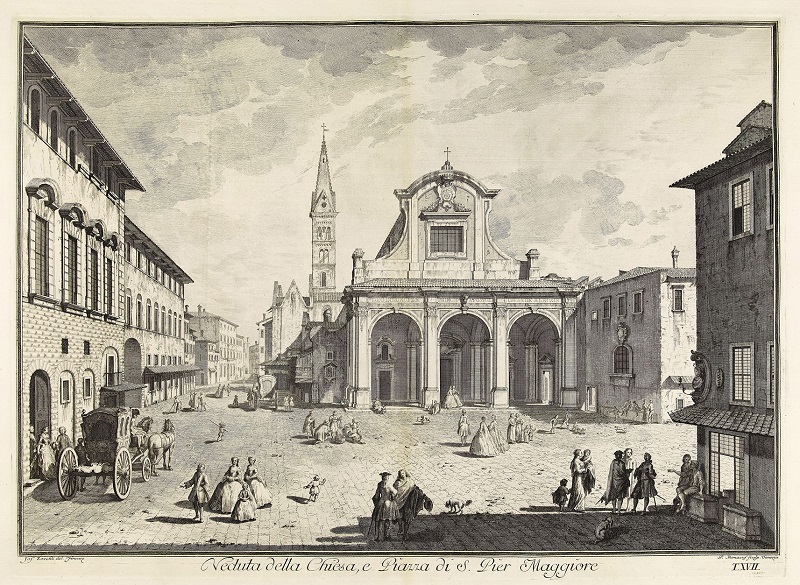The strikingly architectural space that forms the upper portion of Botticini’s Palmieri altarpiece is well-suited to an entrance, forming as it does a sort of triumphal arch heralding great things beyond. And so it is that for years this painting hung over the entrance to the National Gallery’s Sainsbury Wing, oddly well-placed, but in truth of course, entirely out of place. In its new, albeit temporary position, we have a better sense of how this painting might have been seen some 500 years ago, when it adorned the altar of the funerary chapel dedicated to the humanist scholar, poet, politician and apothecary Matteo Palmieri, in the now destroyed church of San Pier Maggiore, Florence (main picture).
This is the latest in a series of National Gallery exhibitions using new research to offer insights into paintings from its own collection. It aims to explain the circumstances in which the altarpiece was made, how it relates to the life and works of its patron, and how stylistic similarities, workshop practices, and a chance encounter with the 16th-century art historian Giorgio Vasari led to it being misattributed to Botticelli for over 300 years.
Central to the project has been the digital reconstruction of San Pier Maggiore using drawings, maps and the substantial fragments of the church’s walls and foundations that remain part of the city’s fabric. A spiral staircase belonging to the church’s bell tower now serves a private apartment, a worn pilaster forms a curious addition to a bathroom wall, while gargoyles and the carved keys of St Peter can still be seen on what is now the Via San Pier Maggiore (Pictured below: Giuseppe Zocchi, View of Church of San Pier Maggiore, 1744).
 The wide format of Botticini’s painting, somewhat unusual for an altarpiece, suggests the location for which it was made, and the reconstruction shows the painting hanging above an altar in a chapel in the church’s south transept. Here it served as an exhortation to the living to pray for the soul of Palmieri, the kneeling donor figure pictured on the left, opposite his wife, Niccolosa. Records show that Palmieri was closely involved in the design of the altarpiece, and in its complex layers of meaning it served not only to assist Palmieri’s soul through Purgatory, but also to preserve and glorify his memory amongst the living.
The wide format of Botticini’s painting, somewhat unusual for an altarpiece, suggests the location for which it was made, and the reconstruction shows the painting hanging above an altar in a chapel in the church’s south transept. Here it served as an exhortation to the living to pray for the soul of Palmieri, the kneeling donor figure pictured on the left, opposite his wife, Niccolosa. Records show that Palmieri was closely involved in the design of the altarpiece, and in its complex layers of meaning it served not only to assist Palmieri’s soul through Purgatory, but also to preserve and glorify his memory amongst the living.
To the citizens of Florence, the multiple and often conflicting references made in this painting would have been clear, and the red robes worn by the ostensibly humble figure of Palmieri would have been instantly recognisable as an allusion to Dante, one of Florence’s most celebrated citizens and the author of the Divine Comedy, c.1308-20.
The Divine Comedy formed the basis of the late medieval understanding of the afterlife, and a century or so after Dante’s description of his journey through Hell, Purgatory and into Heaven, Palmieri’s own City of Life, 1465, was a homage to the great poet, and an attempt to ensure his own place in the Florentine pantheon.
Another of the National Gallery’s altarpieces was made for the high altar of the same church a century before Botticini’s painting, and it is a strangely evocative experience to see them occupying a shared space once again. Jacopo di Cione's altarpiece of 1370-71, with its extensive gilding and flattened spatial construction is, not surprisingly, old-fashioned compared to Botticini’s more naturalistic painting, and yet both share a sense of place. Jacopo’s altarpiece honours St Peter by placing an image of San Pier Maggiore in his hands, while Botticini’s altarpiece locates the Assumption of the Virgin in the Tuscan landscape, the view across to Fiesole and Florence including farms belonging to Palmieri and his wife, the city of Florence depicted as the New Jerusalem.
Overleaf: watch the film Reconstructing the Destroyed Church of San Pier Maggiore, Florence









![SEX MONEY RACE RELIGION [2016] by Gilbert and George. Installation shot of Gilbert & George 21ST CENTURY PICTURES Hayward Gallery](/sites/default/files/styles/thumbnail_125_x_125_/public/mastimages/Gilbert%20%26%20George_%2021ST%20CENTURY%20PICTURES.%20SEX%20MONEY%20RACE%20RELIGION%20%5B2016%5D.%20Photo_%20Mark%20Blower.%20Courtesy%20of%20the%20Gilbert%20%26%20George%20and%20the%20Hayward%20Gallery._0.jpg?itok=3oW-Y84i)





Add comment